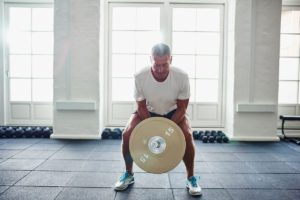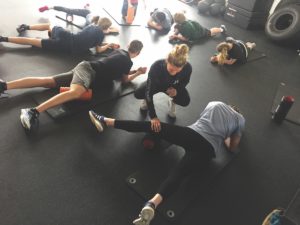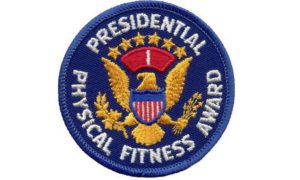Strength/Resistance
Training Guidance for Sedentary Young Women
Study reviewed: Kyröläinen, H., et al. 2017. Effects of combined strength and endurance training on physical performance and biomarkers of healthy young women. The Journal of Strength and Conditioning Research, 32 (6), 1554–61.
Stay Strong to Increase Longevity
Here’s more motivation to stay on top of your functional strength training program. Researchers from China and Indiana University analyzed data from 4,449 older adults in the National Health and Nutrition Examination Survey and found that older people with low muscle strength had more than twice the risk of dying during the study than those with normal muscle strength.
Functional Training for Active, Independent Living
Healthy aging is more than the absence of disease, according to the World Health Organization: “For most older people, the maintenance of functional ability has the highest importance” (WHO 2015).
Colin Milner, founder and CEO of the International Council on Active Aging in Vancouver, British Columbia, echoes that statement: “When looking at the healthy aging market today, the focus is all about function. The World Report on Ageing and Health (WHO 2015) focuses on function as a key element, because loss of functional abilities significantly impacts life quality. Having a chronic health issue, like diabetes or high blood pressure, is manageable, but if I can’t stand up, everything changes.”
Volume Is Key Factor In Building Strength
The secret to increasing strength and muscle mass may have more to do with how much training you do than how often you do it, according to a new report.
Weight Training’s Surprising Effects on Depression
Could a cure for depression be found in the weight room? Data from a study published in JAMA Psychiatry (2018; 75 [6], 566–76) points to that conclusion. The meta-analysis of 33 clinical trials, featuring 1,877 participants, found a link between resistance training (RET) and a reduction in depressive symptoms.
Keto—Fat Chance of Performing Better
The ketogenic diet, a fat-forward meal plan that limits followers to about 20 grams of daily carbs, may help some people shed a little weight (in the short term), but it might not be good news for their athletic pursuits.
The Importance of Exercise for Addiction Recovery
Substance use disorder can wreak havoc on people’s lives. Fitness activity can be a
transformative way for those in recovery to heal, rebuild their lives and find a community of healthy supporters.
According to a study published in Mental Health and Physical Activity in 2011, patients with substance use disorder who exercised while in recovery reported feeling greater strength, improved health, a sense of accomplishment, and increased confidence about staying clean and sober.
Comprehensive Research Project on How to Create an Exercise Habit
24 Hour Fitness® is partnering with the University of Pennsylvania Behavior Change for Good Initiative [BCFG] to support research into what works best for creating lasting exercise habits. With an interdisciplinary team of world-renowned researchers, the BCFG addresses the broader question of how to make positive behavior change stick in aspects of life related to health, education and savings.
Study Launched on Molecular Changes Related to Exercise
In April, Louisiana State University researchers in Baton Rouge held a training for 120 scientists to kick off a national research consortium designed to create a comprehensive map of the body’s molecular responses during and after exercise. The purpose of the $170 million, multicenter, 6-year research project is to promote understanding of how physical activity improves health and prevents disease.
Question of the Month
When you offer training advice to clients, are you discussing the significance of sleep? If yes, are you using sleep trackers and monitoring results? Please describe how you are educating clients regarding the role of sleep in effective training and weight management and share any success stories you have had.
Share your responses with executive editor Joy Keller, [email protected].
Equal Calories Burned ≠ Same Results
Many people fixate on the number of exercise calories they burn. New research, sponsored by Les Mills International, shows that even when two group fitness activities (indoor cycling and a resistance workout) were matched for duration and caloric expenditure, they did not have equivalent metabolic effects—which could influence long-term training results. Lead study author Nigel Harris, PhD, said, “The type of exercise used to burn those calories . . . impacts the long-term positive effects that exercise has on the body.”
Strength Ladder
Strength training classes don’t have to adhere to a classic “sets and reps” template. Why not climb your way up and down this fun fitness ladder for a fast and furious total-body workout? Repetitions are high, but so is the frequency of change, keeping interest piqued during intense work sets.
Strength Ladder Details
GOAL/EMPHASIS: total-body strength training
TOTAL TIME: 1 hour
Pilates for Recreational Athletes
Professional athletes of all kinds have discovered that adding Pilates to their training can improve performance, reduce injury, speed recovery, and help their hardworking bodies stay balanced and healthy (Caple 2016; Knowlton 2016; Saxon 2016). Pilates—a whole-body exercise system that can help you develop strength, functional flexibility, coordination and balance—can offer those same benefits to recreational athletes. A well-rounded program, particularly one offered in a fully equipped Pilates studio, can do wonders for athletes of almost any age, ability or sport.
Strong Hands = Strong Brains?
Could there be a handy new solution for improving cognitive health? Maybe, say U.K. researchers who found that people with significant grip strength tend to have healthier brains.
A for Effort
client: Kent Denver School Students | personal trainer: Laura Bordeaux, strength and conditioning coach, Kent Denver School location: Englewood, Colorado
A complete course load. Think of it as core curriculum—literally. The Kent Denver School, a college-preparatory institution outside of Denver, offers a comprehensive educational experience that emphasizes both academics and sports. That’s where Laura Bordeaux comes in.
Barre Moves for Core Development
Barre classes focus on the core throughout the entire workout and have many ardent followers. Why not use barre-inspired moves in the core section of your HIIT or boot camp class? Your participants will love these variations on classic core fundamentals!
High-Intensity Interval Training for Fat Loss
Two recent studies reveal that high-intensity interval training has the ability to produce high-impact fitness gains in a short time frame.
On This Day in Fitness History
In June 1956, President Eisenhower called for a President’s Conference on Fitness of American Youth to be held at the U.S. Naval Academy. This meeting led to the formation of the President’s Council on Youth Fitness, later renamed the President’s Council on Physical Fitness. The conference convened in response to a study showing that American children were not as fit as European children in tests of muscular strength and flexibility in the trunk and legs.
The Case Against Allowing Injured Instructors to Teach
Owing to the part-time nature of most group fitness instruction jobs, program directors don’t always interact with staff on a daily basis and may not know that an instructor is teaching while injured.
Teen Fitness Matters
Keep encouraging teens to get active. Vigorous exercise is particularly beneficial for lowering their risks of heart disease later in life, according to recent research. Current public health guidelines recommend that children aged 5–18 should do at least 60 minutes of moderate to vigorous physical activity daily to reduce current and future heart disease risks.


















